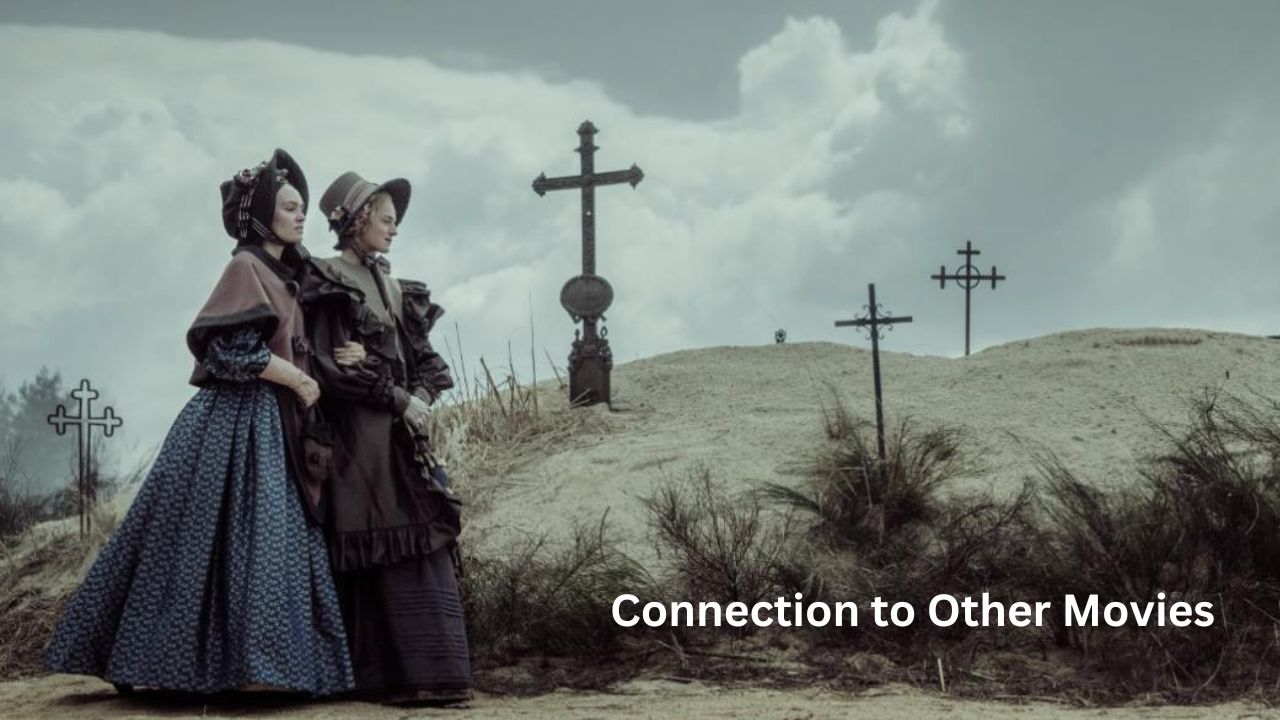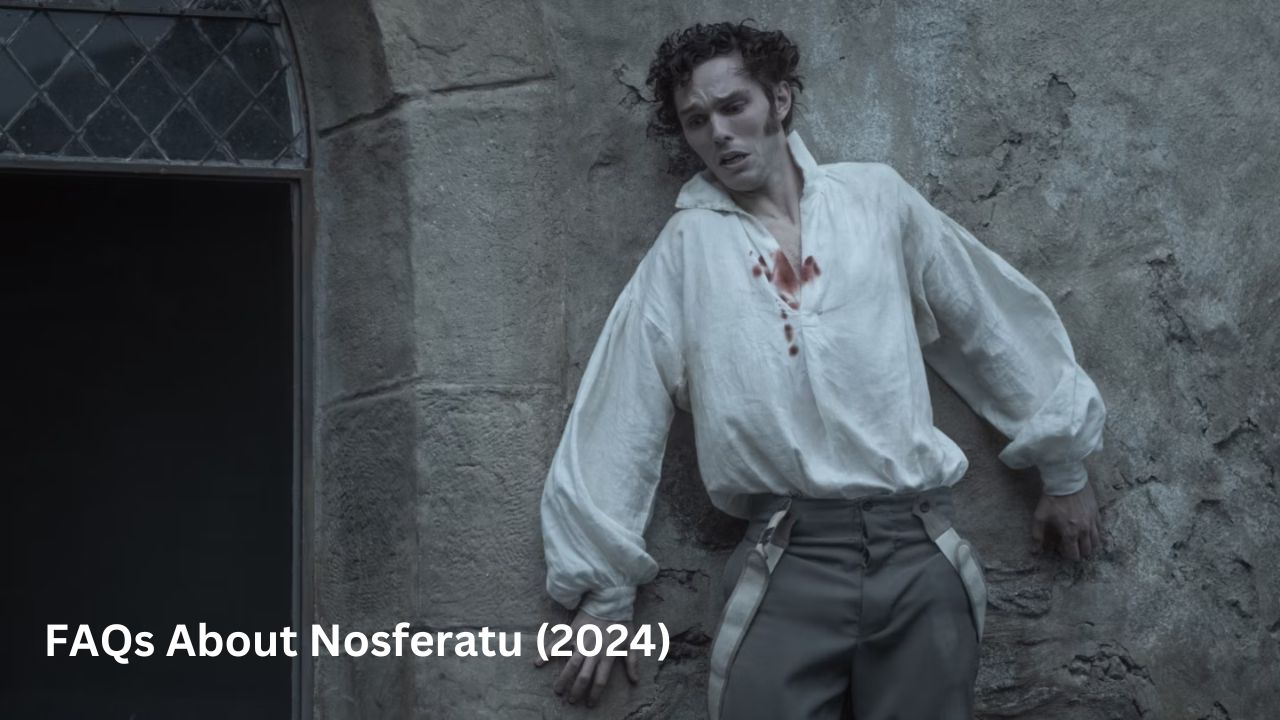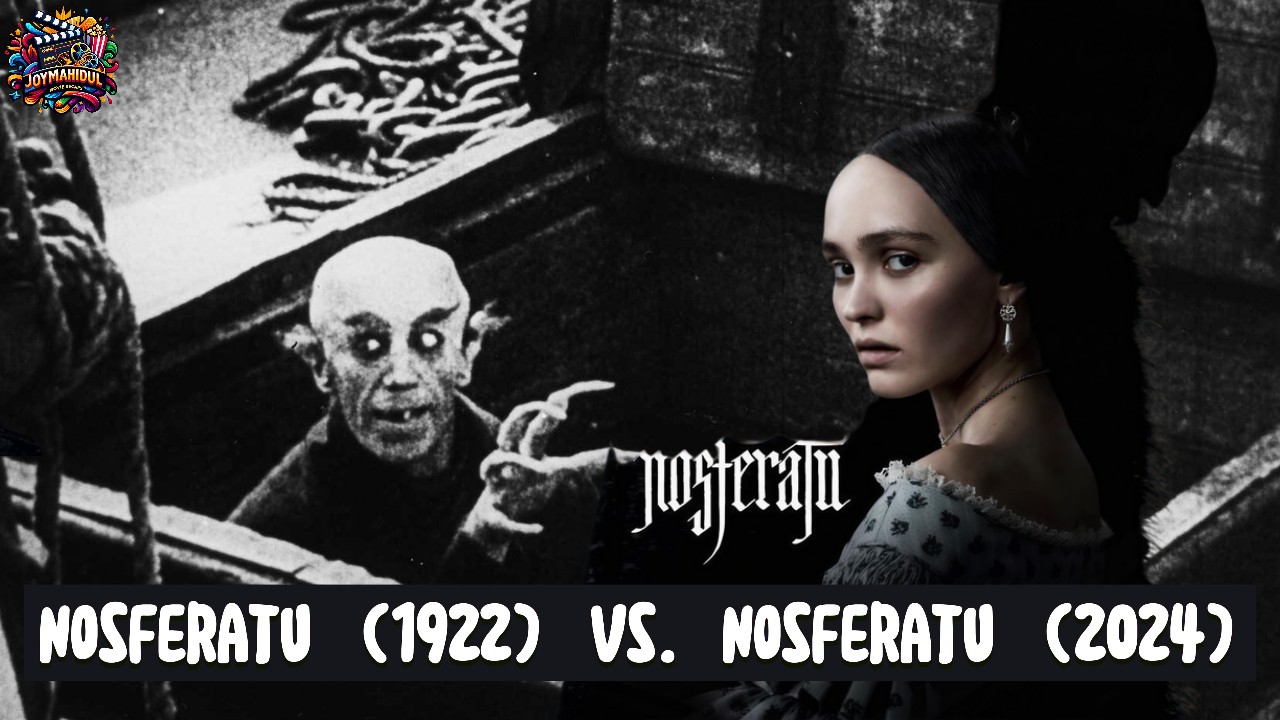Experience the eerie transformation of Nosferatu from 1922 to 2024 – a captivating tale of terror reimagined for modern horror lovers!
Nosferatu: Exploring the Evolution from Classic Silent Film to 2024’s Reimagined Horror Masterpiece
The 2024 remake of Nosferatu, directed by Robert Eggers, and its 1922 predecessor, directed by F.W. Murnau, offer intriguing opportunities for comparison. Both versions explore the same chilling story, yet they differ vastly in terms of style, thematic depth, and execution. Additionally, comparing Nosferatu (2024) to other films in the gothic horror genre further reveals the ways in which modern adaptations, particularly those from directors like Eggers, stand apart from their iconic predecessors.
Overview of Nosferatu (1922) vs. Nosferatu (2024)
This silent movie, Nosferatu (1922), has remained one of the most significant horror movies ever produced. Directed by F.W. Murnau, the film serves as a loose adaptation of Bram Stoker’s Dracula and describes the life of Count Orlok, a vampire who feasts on a couple of youths. Nosferatu is the film that first introduced expressionism, an innovative use of light, and a terribly vampiric tenor to score an avant-garde structure for an entire generation to come.
Fast forward to that very same year, 2024, when Robert Eggers, known for his atmosphere and unsettling thriller-type flicks like The Witch and The Lighthouse, takes on the project: a remake of the classic. Creator Bill Skarsgård himself is Count Orlok, and Ellen Hutter is expected to be played by Lily-Rose Depp, the woman who becomes entwined into the clutches of the vampire himself. Eggers’ Nosferatu is expected to bring a more modern sensibility into the gruesome landscape of Murnau’s original while introducing an entirely different psychological level to the story.
Visual Aesthetics: Expressionism vs. Modern Gothic Style
Murnau’s Nosferatu is famous for its expressionist visuals, which were groundbreaking in 1922. The film’s eerie atmosphere is created through exaggerated shadows, strange angles, and surreal set designs, many of which were achieved through practical effects that were revolutionary for the time. The image of Count Orlok, with his bald head, pointed ears, and rat-like features, remains one of the most terrifying in cinematic history.
In contrast, Eggers’ Nosferatu promises to retain the gothic charm of the original while adding a more modern, cinematic touch. Eggers is known for his meticulous attention to detail and use of natural light, which will likely make for a hauntingly beautiful film. While Murnau’s expressionism is often stark and abstract, Eggers’ visuals will be immersive and grounded in realism, using color palettes and lighting to emphasize the dread of the narrative. The comparisons here lie in how each film uses its visual language to evoke fear: Murnau does it through artistic abstraction, while Eggers aims for a haunting, realistic atmosphere, focusing on the psychological aspects of terror.

Themes: Fear of the Unknown vs. Psychological Horror
The 1922 version of Nosferatu is rooted in the early 20th-century fear of the unknown, drawing from the anxieties of a world that was still grappling with the aftermath of World War I. The vampire, Count Orlok, represents the dark, unfathomable forces that invade and disrupt normal life. Murnau’s film is less concerned with the origins of Orlok or the motivations of his actions. It is more about the overwhelming presence of a force that cannot be reasoned with, a representation of unexplainable evil.
In contrast, Eggers’ Nosferatu is expected to lean heavily into psychological horror, building on the deep character studies of people trapped in nightmarish situations that marked his previous works. While Murnau’s film emphasized the external fear of the vampire, Eggers will likely delve into the internal fears of the characters. This approach means that the focus in the 2024 film may shift from just the terror of the vampire to the psychological breakdowns caused by the encounter with this supernatural entity. How Ellen reacts to the supernatural and the emotional toll on the Hutter family could make the 2024 version more intimate and perhaps more terrifying, as it will explore the complexity of human response to such malevolent forces.
Characterization: The Villain and The Victim
What first comes into somebody’s mind about Nosferatu is that Count Orlok has to play some part in its core structure. He is a figure drawn from another world, a mysterious, almost almost all-encompassing figure. The character is seen as purely evil-in fact it has neither backstory nor motivation, apart from an infinite thirst for blood. That sort of minimalism adds to the terror invoked by the character; Orlok is a creature of pure instinct-neither understandable nor to be reasoned with.
Eggers’ vision may provide a much more nuanced depiction of Orlok, for someone who historically invests himself very much to the psychological complexity of characters-the fact that Eggers’ Orlok might eventually surface with a much more fleshed-out backstory or motivation. It is one thing Eggers is noted for: having problematic characters with dark pasts or emotional scars, perhaps adding depth to evil. Ellen is the counterpart of the Ellen in Murnau: she is just a victim of circumstances, a passive figure swept along by the horrors transcending her. Eggers could do some empowerment for her in what will be her emotional arc once she deals with the nightmares Orlok causes.
Pacing: Silent Film vs. Modern Cinema
Another key difference between the two versions is pacing. The 1922 Nosferatu, being a silent film, is much slower, with long, deliberate shots that build tension through silence and atmospheric detail. The horror in Murnau’s film comes from the gradual revelation of Count Orlok’s true nature, with the pacing mirroring the creeping sense of dread that overwhelms the characters.
Eggers’ version will likely be faster-paced, in line with modern filmmaking conventions, though still keeping a sense of deliberate tension. Today’s audiences expect quicker cuts and more rapid escalation of horror, so Eggers will likely keep the tension building at a steady pace, balancing visual beauty with the horror unfolding onscreen.
Nostalgia vs. Innovation: A Modern Take on a Classic
It still endures timelessly because it broke the mold in the new innovation made in the horror genre, Murnau’s Nosferatu; Eggers’ remake may be exactly the chance to innovate within the genre, though: whether Eggers will prove to be faithful to the original or update it is an open question. We are also asking questions of nostalgia: A certain generation of fans of the original Nosferatu will have different expectations, and whether Eggers will meet through a film that feels both fresh and original those expectations forms one of the major hurdles of the remaking process.
How Eggers’ Nosferatu can be compared to other recent adaptations of classic horror plays such as The Witch or The Lighthouse will help understand what Eggers’ edition could do to further the genre. He mixes elements of historical accuracy and supernatural world-building such that one is often left with a very ambiguous feeling afterward. Thus, his Nosferatu could possibly be the most personal to the original and bring a mythical idea of the vampire to new emotional and psychological heights.

FAQs about the connection between Nosferatu (1922) and its 2024 remake:
1. What is the connection between the 1922 Nosferatu and the 2024 remake?
The updated 2024 remake of Nosferatu is an entirely new rendition of the original silent film produced in the year of 1922. The basic premise for both films involves a vampire, Count Orlok, who disrupts a young pair; however, the remake includes modern cinematic techniques as well as more in-depth character study and psychologically-based themes, as opposed to gruesome visual horror through expressionistic techniques in the original.
2. How does the 2024 Nosferatu differ in terms of visuals compared to the original?
The raw and manipulated Nosferatu employed stark, expressive images-plus exaggerated shadows and strange angles-to convey dread. The 2024 version is expected to come under the purview of Robert Eggers and bring a much more realistic and grounded approach, using natural lights, carefully-designed sets, and modern cinematography to create a more completely incorporated and atmospheric horror experience.
3. Does the 2024 Nosferatu stay true to the original film’s themes?
While the 1922 version focused on primal fear, cultural isolation, and a stark portrayal of evil through Count Orlok, the 2024 version is expected to explore psychological horror more deeply. Eggers’ adaptation will likely emphasize the emotional and psychological breakdown of the characters, particularly the female protagonist, in addition to the supernatural terror.
4. How does the portrayal of Count Orlok in the 1922 film compare to the 2024 version?
In Murnau’s 1922 film, Count Orlok is an almost mythical figure, an embodiment of evil with minimal backstory. In contrast, Eggers’ version may give Orlok more depth, perhaps exploring his origins or motivations, making him a more complex and psychologically intriguing character.
5. What can we expect from the character of Ellen in the 2024 Nosferatu?
Ellen in Murnau’s film is a passive victim, swept into Orlok’s horrors. The 2024 version may provide a deeper character study of Ellen, exploring her psychological journey and her emotional arc as she faces the horrors of Orlok. The film might present her as a more active participant in the story, with more agency and personal growth.
6. What is the significance of the setting in both films?
The setting in both films plays a crucial role in establishing the horror. The original Nosferatu used eerie, stark sets and exterior shots that highlighted the isolated nature of the characters. The 2024 remake will likely retain this sense of isolation but may incorporate more elaborate, atmospheric environments, using natural landscapes and period-accurate details to add depth to the story.
7. Will the pacing of the 2024 Nosferatu be faster than the original?
The pacing of the 1922 Nosferatu is deliberate, typical of silent films, allowing for tension to build slowly. The 2024 version will likely have a faster pace, in line with modern cinema’s expectations for suspense and horror, while still maintaining the slow-burn tension characteristic of Eggers’ style.
8. How will the 2024 Nosferatu appeal to modern audiences?
The newest version of Nosferatu, to be released in 2024, will be a complete investment for the modern audience, owing to the fact that it combines psychological horror with a visually rich and immersive experience. Eggers is known for his ability to combine historical authenticity with that sense of dread and emotional complexity. This should resonate well with contemporary viewers who enjoy their horror a little more character-driven.
9. Will the 2024 Nosferatu be a faithful remake of the 1922 film?
This particular version of Nosferatu for the year 2024 will obviously take the basic story straight from the 1922 film but Eggers would do some updating on the narrative to bring it to perhaps modern sensibilities. There would be more character interrelations and much more expansion on the lore of the vampire, which would include certain psychological nuances that the original version never had.
10. Is the 2024 Nosferatu a reimagining or a direct adaptation?
It shall be a re-envisioning of Nosferatu and would not merely serve as an adaptation. While it borrows, primarily, extra source material apart from that which is originally tied to the 1922 film, Robert Eggers has always been known to interpret classic stories into an art of him. It probably brings the whole new world of vampire tales, merged together with gothic horror and Eggers’ modern psychological slant.
These Frequently Asked Questions sketches the contours on some major differences and similarities between the two Nosferatus for study on how the genre of vampires traveled from the silent yesterdays and evolved to what it is today.
Conclusion: Which Version Stands Out?
In that regard, both set-theater productions of Nosferatu-the 1922 staged play and the 2024 remake by Robert Eggers-have their individual appraisal of what they can procure from that source material. It holds exceptionally important status in the cinema history books because of the innovative techniques employed in it and its ability to create a pure, primal fear with the pictures-the silent movie is a piece of much-required viewing for anyone studying the world history of horror.
In contrast, Eggers’ Nosferatu will probably just take the original’s best features: its haunting visuals, ideas of isolation, and the like-and inject them with contemporary sensibility, deeper character-building, and psychological depth. Generally, it will probably find favor with fans of Eggers’ earlier works, those who enjoy an atmospheric, slow-burning story steeped in psychological horror.
Which film may be “better” ultimately depends on your point of view: Miles ahead in terms of brilliant visual art and historical significance, Murnau’s Nosferatu may yet be the superior film; but if psychologically slanted characters in a modern and character-driven story appeal more, Eggers’s remake could be regarded as the most exciting modern advance on the theme.
So, which Nosferatu, in your opinion, will have more resonance with the horror genre? Comments below, and keep it tuned for more discussions and updates on what is to come in 2024. Also, don’t forget to check out more of our movie analyses at Joymahidul.com for reviews and deep dives into your favorite films.
Nosferatu (1922): A Timeless Classic
But in truth, Nosferatu (1922) has a brilliant scenery and mood created by F.W. Murnau, and the remake for 2024 is awaited. This horror film silent era was the first in doing so. It laid a mold for that kind of haunting atmosphere that resonates with audiences even today. With an IMDb score of 7.9/10, it is considered to be one of the greatest horror movies ever made.
For those who want to experience the eerie brilliance of the original, you can watch Nosferatu (1922) on various streaming platforms or purchase the Blu-ray/DVD from Amazon: Buy the 1922 Nosferatu Movie on Amazon.
Watch the Upcoming Nosferatu (2024)
The 2024 version of Nosferatu, directed by Robert Eggers and starring Bill Skarsgård and Lily-Rose Depp, will release on December 25, 2024, with theatrical availability nationwide. It’s expected to hit streaming platforms like Peacock after its theatrical run.
Stay updated with details or reserve your tickets early through Amazon.
Ratings Comparison
- Nosferatu (1922): IMDb Rating: 7.9/10
- Nosferatu (2024): Ratings will be available post-release, though early previews highlight its gripping visuals and intense performances.
For more insights, visit joymahidul.com and explore #joymahidul for exclusive content and reviews!
